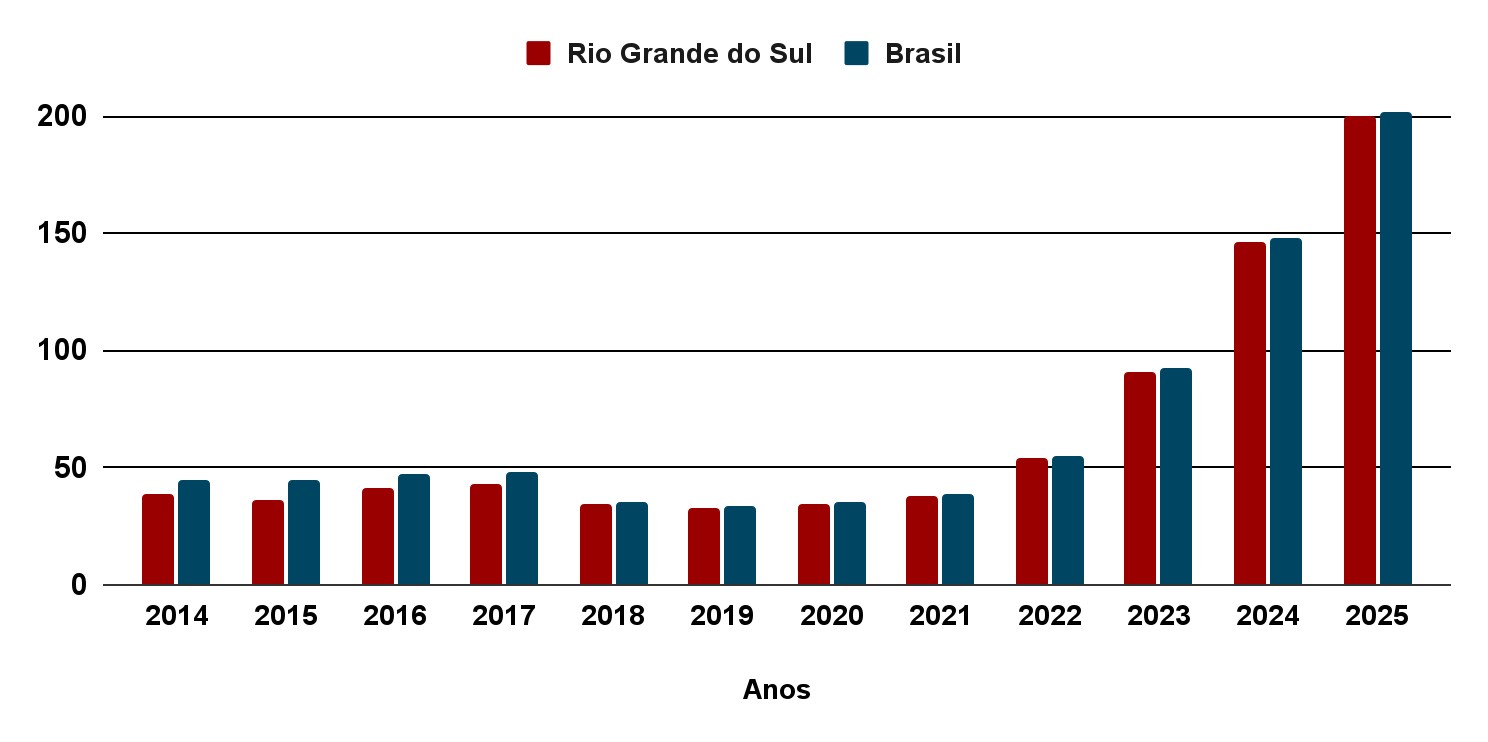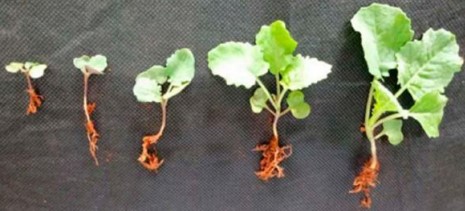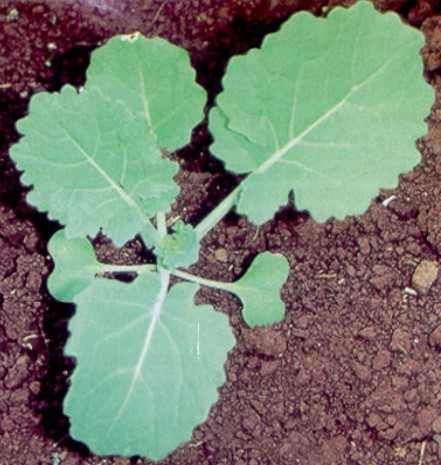According to the National Supply Company (Conab), canola (Brassica napus L.) cultivation has been spreading in winter crops in Rio Grande do Sul (RS) throughout the harvests. The growth of canola is evident when we compare the areas cultivated in the State in 2023 (91,000 hectares) and 2024 (146,000 hectares). This expected increase is even greater for the 2025 winter harvest, which foresees an area of 200,000 hectares cultivated with the crop.
Thus, in addition to the economic aspects presented by this winter crop, it is observed that canola offers a distinct type of root, enabling the breaking of the cycle of pests and diseases and the decompression of the soil, in addition to helping to control ryegrass, a weed that is difficult to manage in wheat cultivation.
In view of the above, we can observe in Graph 1 the comparison between Rio Grande do Sul and the national scenario in the growth of canola implementation and the forecast for the agricultural year of 2025.
Graph 1: Growth of canola crops in RS (in thousand ha¹).

Source: Conab, 2025.
? Good canola nutrition linked to the initial start of the crop
In order to successfully grow canola, the producer must pay attention to soil fertility, more specifically to the adequate supply of nitrogen (N) and sulfur (S), since the crop in question has a high demand for these nutrients. In this sense, soils with a good organic matter (OM) content are essential to meet the demand for these two nutrients, unlike soils that are poorer in OM and acidic, which can compromise the availability of nutrients in the initial phase of crop establishment.
On the other hand, according to the Brazilian Society of Soil Science (SBCS), with regard to phosphorus (P) and potassium (K), it is observed that in soils that commonly present good soybean and corn productivity yields for the region's standards, they will probably not present a deficiency for canola cultivation either.
? Importance of canola nutrition
Adequate nutrition is important for the initial development of canola and throughout the cycle to achieve high yields. In image 1, we can observe the phenological development of the plant to identify the ideal time for top dressing application, because the essential nutrients at some point in the cycle will be directly related to the plant's metabolism, such as enzymes, hormones or structural material.
Image 1: Phenological development of canola up to the four true leaf stage.

Source: Cynthia Gonçalves Guimarães.
Image 2: Presentation of four true leaves (ideal phase for nitrogen fertilization in topdressing).

Source: Embrapa, 2007.
Nitrogen is the macronutrient that the plant requires the most. The recommendation is 15 kg ha-1 of N at sowing (expected yield of 1.5 t ha-1), and the rest in topdressing, remembering that for each additional ton in crop yield, 20 kg ha-1 of nitrogen should be added.
A lack of N in the soil can lead to reduced productivity, and doses higher than recommended can cause an elongation of the vegetative phase, thus increasing the susceptibility of pathogens and decreasing the oil content.
In addition, canola requires 14 nutrients, especially boron, with a requirement of 0.2 kg ha-1, and sulfur, with an average demand of 25 kg ha-1.
? Elements that deserve attention in canola nutrition
Boron (B) and sulfur (S) are required in greater quantities in canola areas when compared to other winter crops. The need for boron is greater during the flowering period and grain filling, since the deficiency of this element limits the growth of the pollen tube, explaining the greater demand for this micronutrient in the reproductive phase.
A lack of N in the soil can lead to reduced productivity, and doses higher than recommended can cause the vegetative phase to be prolonged, thus increasing the susceptibility of pathogens and decreasing the oil content.
In addition, canola requires 14 nutrients, especially boron, with a requirement of 0.2 kg ha-1, and sulfur, with an average demand of 25 kg ha-1.
? Elements that deserve attention in canola nutrition
The need for a good supply of S in canola cultivation is essential to increase productivity and to increase the oil content in the grains and ensure seed quality. A deficiency of the nutrient leads to greater abortion of siliques, in addition to these structures becoming deformed and small.
? Boron fertilization in canola crops
Regarding boron, it is recommended to use mineral fertilizers, such as YaraVita Bortrac (10.9% B), YaraVita Biotrac (1.1% B) and YaraVita Phosamco Bio (0.02% B). In this sense, to maximize photosynthesis and flower and pod set, the use of BIOTRAC + BORTRAC is recommended. In addition, boron provides high absorption of nutrients and benefits with productive efficiency, providing better rooting, allowing the plant to reach deeper roots.
? Sulfur fertilization in canola crops
To supply sulfur, it is recommended to use gypsum or even fertilizers that have S in their formulation, such as YaraVita Glytrel MnP (3.8% S), YaraVita Folicare (2.8% S) and YaraVita Thiotrac (22.7% S), before sowing. In the case of top dressing, ammonium sulfate [(NH?)?SO?] can be used, which has 21% nitrogen and 24% sulfur in its composition.
In view of this, we note that, unlike other grain cereals, canola crops require attention in relation to boron and sulfur, which are extremely important for crop yield and productivity, in addition to influencing the oil content in the seed.
Text written by Grazieli Greth Sperling and Márlon Ribeiro Feldens, students of the Agronomy course at UFSM, Frederico Westphalen campus, members of the Tutorial Education Program - PET Agricultural Sciences, under the supervision of the tutor, professor Dr. Claudir José Basso.
Keywords: Canola; Winter; Nutrition: Boron; Sulfur;
REFERENCES
AGRO URBAN. Increasing boron can make a difference in canola cultivation. 2024. Available at: https://www.agrourbano.com.br/release/637/incremento-de-boro-pode-ser-o-diferencial-no-cultivo-de-canola . Accessed on: March 19, 2025.
COSSUL, L. Factors that interact and affect canola crop productivity. 2007. Available at: https://repositorio.ifrs.edu.br/bitstream/handle/123456789/1688/1234567891688.pdf?sequence=1&isAllowed=y. Accessed on: March 19, 2025.
ESTEVEZ, R. L. et al. Canola (Brassica napus var. oleifera) Culture. Scientia Agraria Paranaensis, v. 13, n. 1, p. 1–9, 2014. https://e-revista.unioeste.br/index.php/scientiaagraria/article/view/8177 . Accessed on: March 19, 2025.
GUERRA, W. E. X. Boron fertilization in canola crops in a sandy red latosol in western São Paulo state. 2013. Available at: http://bdtd.unoeste.br:8080/jspui/bitstream/tede/590/1/Wellington%20Eduardo%20Xavier%20Guerra.pdf . Accessed on: March 18, 2025.
JÚNIOR, R. S. DE O. Residual activity of imazaquin and alachlor + atrazine for sequential planting of canola. Ciência rural, v. 31, n. 2, p. 219–224, 2001. https://www.scielo.br/j/cr/a/rGDpCvKJQtBqb8GvYs8Pdzx/?lang=pt . Accessed on: March 18, 2025. 2025.
SILVA, E. “Winter soybeans”: area planted with canola breaks record in RS. Available at: https://www.trf1.jus.br/sjgo/publicacoes-de-interesse-publico/soja-de-inverno-area-plantada-com-canola-bate-recorde-no-rs. Accessed on: March 19, 2025.
TOMM, G. O. Technological indicators for canola production in Rio Grande do Sul. Passo Fundo: Embrapa Trigo, 2007. 32 p. (Embrapa Trigo. Production systems, 3).
TOMM, G. O. Manual for canola cultivation. Passo Fundo: Embrapa Trigo, 2003a. 22 p. 1 Folder
3TENTOS. Canola gains strength in RS with support from 3tentos. 2025. Available at: https://revistacultivar.com.br/noticias/canola-ganha-forca-no-rs-com-apoio-da-3tentos. Accessed on: March 19, 2025.




